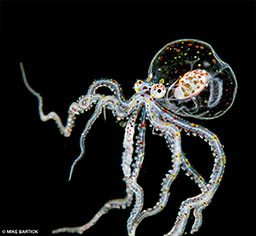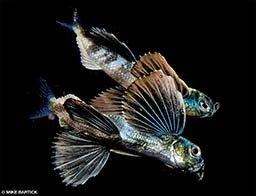My immersion into blackwater diving began off the Southern California coast. A group of friends and I watched a very interesting slideshow on the subject one evening, and afterward I eagerly accepted their invitation to join them for a blackwater dive the next night. The images of weird jellyfish, salps, pelagic tunicates and other transparent alien subjects had seriously spiked my creative spirit.
The following morning I anticipated the dives with a burning spirit of adventure combined with greenhorn jitters. I had no idea what to expect or how the dives would work.

I did my first open-ocean dives in broad daylight, which allowed me to gain some experience and muscle memory at a reasonably comfortable pace. Even so, my personal-safety alarm bells rang loudly during those first dives. I’ve just inserted myself directly into the food chain, I thought. But it didn’t take long before curiosity began to take over. True blackwater diving can be an altogether new experience. Backrolling into an inky abyss with only the beam of your torch to light the way can cause some anxiety. Adjusting to this unfamiliar environment may take several dives, but as fascination begins to take over, you will discover what seems like a parallel universe. The experience will command your undivided attention, so take certain preventive measures prior to each blackwater diving experience.
Drifting in the dark of night in the open ocean should be taken seriously. Prepare yourself physically and mentally, and put your safety first by doing the following:
- Be sure your torch is fully charged and that you have a backup.
- Shine your light on your phosphorescent gauges so they will glow brightly.
- Secure your camera to your body so your hands are free when you need them.
- Make a bailout plan in case a diver drifts out of sight of the line.
- Establish an emergency recall system.
- Limit the number of people in the water.
- To prevent task loading, ensure you’re familiar with your equipment.
- Prepare your camera before you enter the water (turn on the strobes and focus lights, and set the shutter speed, aperture and ISO).
- Never let your ego or anyone else’s override common sense.
After entering the water, descend slowly, stabilize your buoyancy, and relax. Depth can easily be misjudged because there are no points of reference. Pay close attention to your ears throughout the dive; they are often the first indicators of a depth change.

The Downline
For an extra measure of protection we created an illuminated safety downline using a weighted 100-foot rope with a 10,000-lumen Kraken Solar Flare at the top and eight 1,000-lumen lights at various depths. We secured the rope to the boat and deployed a sea anchor to slow the drift of the boat if needed. It’s not uncommon for the wind to blow in one direction while the current pushes in another, so awareness and good judgment are imperative. Some blackwater divers use harness systems, either purchased or homemade. I prefer the freedom of being untethered and relying on the lighted downline as a reference point. The downline is an indispensable piece of blackwater diving equipment: Besides enhancing safety, it draws in larval subjects and other pelagic drifters.
Technique
Both your diving and shooting techniques while drifting are critical, and getting them right requires some practice. The more you do this, the better you will become at recognizing and approaching subjects. Allow for three or four attempts before the magic begins to happen.
Transparency rules in this black world, and finding and tracking your subjects would be nearly impossible without your torch. Swim slowly into the current as you search for a subject. When you spot one, advance slowly; try to use its momentum in your favor. Remember that pressure waves you generate can cause the delicate little drifters to retract or spook, so try to let them come to you. Moving as little as possible, find a subject and calmly drift along with it. Many of these creatures may be light sensitive and become active just as your torch illuminates them. Cupping your light with your hand and allowing a small beam to pass through your fingers is a great technique for getting close and focusing. A focus light with multiple power settings can serve this purpose as well. Being quick on the shutter release and timing your shot are also important. Many subjects will begin to spin or close up when lit, even when they’re lit for only a few seconds. I like to keep my left hand on the focus light and my right hand free to make quick camera adjustments on the fly.
Camera Settings
I recommend a 60mm lens for this type of work as the close working distance allows you to light your subjects without too much backscatter. This is tight work, so facing your strobes toward the housing helps prevent overlighting the background. Some evenings there is so much crud in the water that avoiding backscatter is impossible. But keep in mind that this is the nature of the environment, and a little backscatter isn’t so bad. Anyway, white particles on a featureless field of black are pretty easy to remove in postproduction.
Use a higher ISO setting and lower strobe power: Repetitive firing is often needed, and waiting for the strobes to recycle can be counterproductive. Because the subjects are primarily transparent with small areas of opaqueness, focusing on them can be challenging. Select a torch with a tight beam, and set it to a lower power during the initial search. Once you see your target, make your approach, and redirect the light to help your camera’s autofocus lock on.
Try these initial settings:
- ISO 360
- f/14 @ 1/200 sec
- strobes at 1/2 to 3/4 power
White modeling lights are best; a red light imparts onto the subject a strange color cast that is hard to correct in postprocessing.
Many encounters in blackwater may be once-in-a-lifetime opportunities, so it’s important that the technical aspects of your images are spot on. Once your strobe position is set, use your f-stop dial like a dimmer switch. Close down your f-stop if the subject is reflective, and open up your f-stop if you need more light. Use the camera’s LCD screen for immediate review. Get close to the subject, keep one eye in the viewfinder and one on the downline. Quickly study subjects’ movements, and photograph them to the best of your ability.

What Will I See?
Imagine diving into a 3-D science-fiction movie that rolls from the moment you slip into the water until the moment you’re back on the boat. Unlike a typical muck dive, there’s no queuing up to shoot a subject, and each person will return with his or her own set of unique images, angles and stories. It’s impossible to manipulate the subjects you’ll encounter or to influence their posture. This is a very reactive discipline, with the subject defining the shooting parameters.
Jellyfish and comb jellies are the creatures most commonly encountered when drifting along in blackwater. While some jellyfish can grow to enormous sizes, the ones spotted most frequently are about palm-sized or smaller. The jellyfish we’re most familiar with are the gelatinous creatures that resemble an umbrella with dangling stinging tentacles used to ensnare prey. These move along brainlessly and heartlessly by pulsing and drifting on the current. Comb jellies, on the other hand, typically have more of an angular shape and tiny rows of cilia that propel them through the water. They often produce small amounts of red, green and blue light along their bodies. There are hundreds of different types, shapes and sizes of jellyfish and comb jellies.
Then there are larval gastropods (snails, slugs and shellfish), pteropods (free-swimming pelagic snails) and an array of other developing subjects in the prejuvenile stage. Perhaps the most bizarre are the body snatchers known as Phronima sedentaria, which resemble the creatures from the movie Alien. These macabre little monsters eat the interiors of pelagic tunicates and move into the remains, laying eggs in them and using them for shelter. They move continuously to provide their eggs with a constant flow of fresh water.
The marquee attractions are always the larval fish, particularly those in the settling stage. Subjects in this stage of development look nothing like their adult selves, and when processing the images later I often find myself wondering, What the heck is that?
A proper blackwater dive really is like a glimpse into inner space, and the more you do it, the more you appreciate being able to see it.

Where to Dive?
Blackwater diving can be done just about anywhere. There are now dive operators that offer it in locations as diverse as Jupiter, Fla.; Kona, Hawaii; British Columbia; and Anilao, Philippines. Every location has its own variety of organisms — a blackwater excursion should be included in any dive trip when possible.
Don’t limit your adventures into the night to deep open waters. Check out shallower environments, or drift in proximity to a wall. Most recently we’ve experimented with using a single Solar Flare torch planted in the sand at 60 feet, angled upward and toward deeper water. I’ve found this technique works well for cephalopods and larval subjects. This also provides a great way to introduce divers to this new world without the anxiety of an open-ocean blackwater dive. Larval eels, flounders and larval sea mantises can be seen in this more confined style of dive.
When diving near the point of an island, tidal action can promote currents that carry all sorts of little treasures. Even a calm bay might produce something unique, such as a settling wonderpus or hunting bobtail squids. There’s no limit to where blackwater diving can be done — even freshwater holds tiny alien life.
Consider these techniques and suggestions that offer a jumping-off point toward safely developing your own approach to blackwater diving. Experiment often and in different locations, explore our inner universe, and remember to always have fun. In the darkness there is a world rarely seen: bizarre, exciting and awaiting the beam of your light.
| © Alert Diver — Q2 2017 |